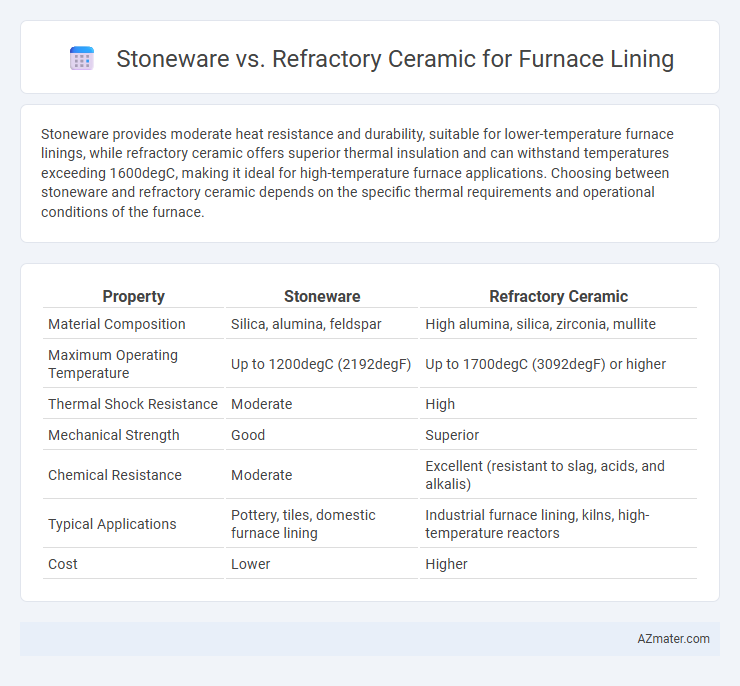Stoneware provides moderate heat resistance and durability, suitable for lower-temperature furnace linings, while refractory ceramic offers superior thermal insulation and can withstand temperatures exceeding 1600degC, making it ideal for high-temperature furnace applications. Choosing between stoneware and refractory ceramic depends on the specific thermal requirements and operational conditions of the furnace.
Table of Comparison
| Property | Stoneware | Refractory Ceramic |
|---|---|---|
| Material Composition | Silica, alumina, feldspar | High alumina, silica, zirconia, mullite |
| Maximum Operating Temperature | Up to 1200degC (2192degF) | Up to 1700degC (3092degF) or higher |
| Thermal Shock Resistance | Moderate | High |
| Mechanical Strength | Good | Superior |
| Chemical Resistance | Moderate | Excellent (resistant to slag, acids, and alkalis) |
| Typical Applications | Pottery, tiles, domestic furnace lining | Industrial furnace lining, kilns, high-temperature reactors |
| Cost | Lower | Higher |
Introduction to Furnace Lining Materials
Furnace lining materials like stoneware and refractory ceramic are essential for thermal insulation and structural integrity in high-temperature environments. Stoneware is known for its dense, non-porous composition that offers moderate heat resistance and durability, making it suitable for less extreme applications. Refractory ceramic exhibits superior thermal stability and corrosion resistance, enabling it to withstand temperatures exceeding 1600degC, which makes it ideal for industrial furnaces and kilns.
Key Differences Between Stoneware and Refractory Ceramic
Stoneware is a dense, non-porous ceramic fired at lower temperatures, known for its durability and moderate thermal resistance, making it suitable for less extreme furnace environments. Refractory ceramic, however, is engineered to withstand exceptionally high temperatures and thermal shock, often composed of alumina, silica, and other oxides designed specifically for furnace lining applications. Key differences include their firing temperatures, thermal stability, and chemical composition, with refractory ceramics offering superior heat resistance and longevity in industrial furnaces compared to stoneware.
Thermal Performance Comparison
Stoneware exhibits high thermal shock resistance and moderate thermal conductivity, making it suitable for furnace lining applications requiring durability under fluctuating temperatures. Refractory ceramics offer superior thermal insulation with lower thermal conductivity and higher melting points, enhancing energy efficiency and longevity in high-temperature environments. The choice between stoneware and refractory ceramic depends on the specific thermal performance needs, such as operating temperature range and heat retention capabilities.
Durability and Longevity
Stoneware offers high durability with excellent thermal shock resistance, making it suitable for moderate furnace temperatures while maintaining longevity under steady conditions. Refractory ceramics provide superior durability at extreme temperatures due to their enhanced chemical stability and resistance to thermal degradation, extending furnace lining lifespan significantly. For applications demanding maximum longevity at high heat, refractory ceramics outperform stoneware in structural integrity and wear resistance.
Chemical Resistance Attributes
Stoneware exhibits moderate chemical resistance, effectively withstanding acidic and basic slags commonly found in industrial furnaces, but it can degrade over time when exposed to highly corrosive environments. Refractory ceramics, designed with advanced alumina, silica, and zirconia compositions, offer superior chemical resistance, maintaining structural integrity against aggressive molten metals and fluxes. The enhanced durability of refractory ceramics under extreme chemical conditions makes them preferable for furnace lining applications requiring long-term resistance to corrosion and chemical attack.
Cost Analysis and Budget Considerations
Stoneware furnace linings typically offer lower upfront costs due to their widespread availability and ease of manufacturing, making them a budget-friendly option for small to medium-scale applications. Refractory ceramics, while more expensive initially, provide superior thermal resistance and longer lifespan, reducing maintenance and replacement expenses over time. Evaluating total cost of ownership reveals that refractory ceramics may be more cost-effective for high-temperature industrial furnaces despite the higher initial investment.
Installation and Maintenance Requirements
Stoneware furnace linings offer straightforward installation with lower upfront labor due to their modular design, but require regular maintenance to prevent cracking under thermal stress. Refractory ceramic linings demand precise installation techniques, such as careful application and curing processes, ensuring durability under high temperatures with less frequent maintenance. Proper selection hinges on balancing installation complexity with long-term upkeep needs for optimal furnace performance.
Suitability for High-Temperature Applications
Refractory ceramics outperform stoneware in high-temperature furnace lining due to their superior thermal stability and resistance to thermal shock at temperatures often exceeding 1,500degC. Stoneware, typically suitable for temperatures up to 1,200degC, offers durability but lacks the advanced heat resistance needed for industrial furnace environments. Selecting refractory ceramic materials ensures enhanced longevity and efficiency in furnaces operating under extreme thermal conditions.
Common Applications in Industry
Stoneware is commonly utilized in kiln furniture and furnace linings for general heat treatment processes due to its moderate thermal shock resistance and durability. Refractory ceramics, with higher melting points and superior thermal stability, are preferred in high-temperature industrial applications such as metallurgical furnaces, glass melting tanks, and petrochemical reactors. The choice between stoneware and refractory ceramic linings depends on the operating temperature and chemical exposure typical in industries like steel manufacturing, ceramics production, and chemical processing.
Choosing the Best Material for Your Furnace
Stoneware offers excellent thermal shock resistance and durability, making it suitable for moderate temperature furnace linings. Refractory ceramics provide superior heat retention and can withstand extremely high temperatures above 1600degC, ideal for industrial furnaces requiring enhanced thermal insulation. Selecting the best material depends on your furnace's operating temperature, frequency of thermal cycling, and the specific thermal conductivity needed for efficient energy use.

Infographic: Stoneware vs Refractory Ceramic for Furnace Lining
 azmater.com
azmater.com